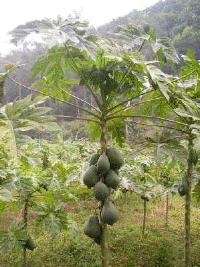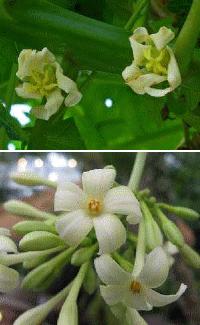 SKC Films Library SKC Films Library |
| SKC Films Library >> Agriculture >> Plant Culture >> Fruit and Fruit Culture |
| Papaya one of the best sources of vitamin C in the plant kingdom
Although it looks like a tree, Carica papaya is actually a short-lived, fast-growing, woody herb with a single stem growing from 16 to 33 feet tall. The hollow green or deep purple "trunk" is straight and cylindrical with prominent leaf scars. Its diameter may be from 2 or 3 inches to over a foot at the base. The spirally arranged leaves, each of which is 20-28 inches in diameter, are confined to the top of the stem. The five-petalled flowers are fleshy, waxy and slightly fragrant. Some plants bear only short-stalked female flowers, or bisexual (perfect) flowers, also on short stalks, while others may bear only male flowers, clustered on panicles 5 or 6 feet long. Some plants may have both male and female flowers. Others at certain seasons produce short-stalked male flowers, at other times perfect flowers. How pollination takes place in papayas is not known with certainty. Wind is probably the main agent, as the pollen is light and abundant, but thrips and moths may assist. Hand pollination is sometimes necessary to get a proper fruit set. papaya 'tree' male (top) and female (bottom) papaya flowers There are two types of papayas, Hawaiian and Mexican. The Hawaiian varieties are the papayas commonly found in supermarkets. These pear-shaped fruit generally weigh about 1 pound and have yellow skin when ripe. The flesh is bright orange or pinkish, depending on variety, with small black seeds clustered in the center. Hawaiian papayas are easier to harvest because the plants seldom grow taller than 8 feet. Mexican papayas are much larger than the Hawaiian types and may weigh up to 10 pounds and be more than 15 inches long. The flesh may be yellow, orange or pink. A properly ripened papaya is juicy, sweetish and somewhat like a cantaloupe in flavor, although musky in some types. The fruit (and leaves) contain a latex called papain which helps digestion and is used to tenderize meat. The edible seeds have a spicy flavor somewhat like that of black pepper. Papayas are often sliced and eaten by themselves or served with a myriad of other foods. They can also be cooked to make chutney or various desserts. Green papayas should not be eaten raw because of the latex they contain, although they are frequently boiled and eaten as a vegetable. In the West Indies, young leaves are cooked and eaten like spinach. In India, seeds are sometimes used as an adulterant in whole black pepper. Papayas are very nutritious, providing about 103% of the recommended daily allowance of vitamin C (far more than provided by either oranges or lemons), and significant amounts of vitamin A, B-complex vitamins, vitamin E, potassium, calcium, and dietary fiber. And, all of that nutrition comes with only 39 calories, and 0 cholesterol. Papaya has also proven to be a natural remedy for many ailments, including (but not limited to) digestive disorders, skin irritations, and ringworm infections. Believed to be native to southern Mexico and Central America, the papaya is now present in tropical and subtropical areas around the world. Successful commercial production today is primarily in Hawaii, tropical Africa, the Philippines, India, Ceylon, Malaya and Australia, apart from the widespread but smaller scale production in South Africa, and Latin America. SOURCES |
| SKC Films Library >> Agriculture >> Plant Culture >>
Fruit and Fruit
Culture This page was last updated on 06/16/2017. |


